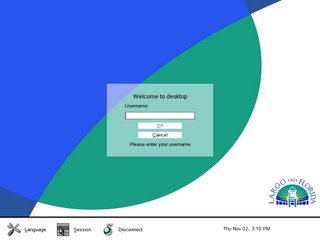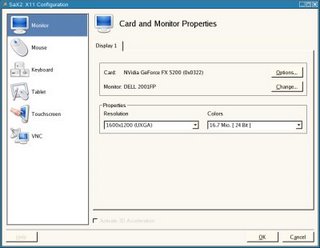Firefox 2.0
We upgraded the whole City to Firefox 2.0 Tuesday at noon. It went off without a hitch. All of the users bookmarks and settings all worked. To the developers, thank you for a nice, simple upgrade. I just moved the launch script to the new release and everyone just picked it up the next time they launched the program.
OpenOffice 2.0.4
We upgraded the City to 2.0.4 and a nasty little printing bug forced me to roll it back. It's been fixed in a CWS but looks like we have to wait for 2.1 to get it. Upgrade and rollback were handled in seconds and easy, but I hate losing the eyes that would be reviewing the rest of the new code.
Evolution For SLED
Harish and the guys on the other side of the world are doing great work squashing Evolution bugs. I have spent significant time debugging and testing Proxy and other GroupWise features so that we can roll them out to our users.
SLES/SLED/Thin Client Testing
I hacked a GDM splash page for login with our colors and logo. People really like little customized touches like this. Really, I didn't steal the colors from Logitech :) [follow link to my blog if image doesn't display]

We found a nvidia FX5200 video card for testing in the thin client. We needed one that plugged into a PCI slot, and has no fan. The thin clients has no moving parts, an we wanted the card to work the same way. The expansion slot was added to the thin client, and then the card installed. SLES found the card and kicked it right into 1600x1200 and it's working. Below are pics of the expansion slot added to the thin client on the left side, and the yast2 program finding the right video card. This is the first thin client I've seen with 3D support, so for grins I ran GoogleEarth for Linux over remote display. :) Well, it works, but isn't fast enough to deploy. I think that we will probably flash the devices with this binary and it will just run locally. Work continues on the Citrix/XDM chooser and getting X to flip between modes correctly. I'm also still working on remote sound.


9 comments:
Why don't you use LTSP? Did you look at it and find it lacking? Current LTSP does remote sound and they are working on running apps on the thin client.
The big test for us is remote Xgl which we were told in theory should work. A SLED server would be able to push down the cool eye candy to the thin clients. It's all experimental to push the limits of the devices to see how far we can take them over their 10 year duty cycle.
If you really need/want the eye candy on your thin clients, I'd recommend that you use AIGLX/Xorg rather than Xgl, which is processor-hungry and still somewhat buggy. The latest nvidia drivers support AIGLX/Xorg.
You're planning on rolling out NVidia cards? Have fun not being able to debug your kernels.
Dave, thanks so much for your posts.
I assume you're upgrading the software on the Application Servers (like you described back in august); there's something I don't understand: When updating Evolution, for instance, do you upgrade the rest of the Gnome dependencies on that server?
And what about the Gnome server? does it have to be upgraded as well?
Regarding your question about upgrades. We tend to stay on releases built by the various vendors. For instance, we are testing Evolution 2.6 on SLED 10, even though 2.8 and now 2.9 are available in source form. We don't build them from source for reasons of support contacts. Novell will be creating a SP1 for SLED 10 which will contain newer libraries and hopefully should allow us to upgrade. The same thing with OpenOffice. We bring down the official builds from Sun, and test them on a supported operating system and then deploy. For bleeding edge work, we build small servers with newer libraries and a few of us use those fulltime to shake out issues that will be 6-8 months down the road.
The primary GNOME desktop server is very old, and because the two software packages never touch each other, we don't have library issues. The libraries only have to match the primary application of that server.
Post a Comment